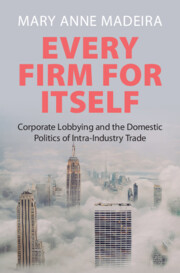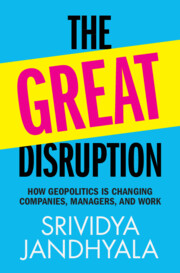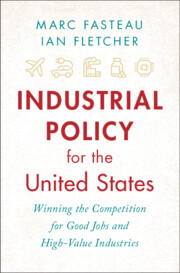Refine search
Actions for selected content:
60 results
Semiconductor Tariffs as Policy Whiplash
-
- Journal:
- World Trade Review , First View
- Published online by Cambridge University Press:
- 11 August 2025, pp. 1-8
-
- Article
-
- You have access
- Open access
- HTML
- Export citation
Tariffs versus Subsidies: Protection versus Industrial Policy
-
- Journal:
- World Trade Review , First View
- Published online by Cambridge University Press:
- 11 August 2025, pp. 1-8
-
- Article
-
- You have access
- Open access
- HTML
- Export citation
3 - The Domestic Politics of Intra-Industry Trade: A Theoretical Model
-
- Book:
- Every Firm for Itself
- Published online:
- 21 July 2025
- Print publication:
- 07 August 2025, pp 40-59
-
- Chapter
- Export citation
6 - Intra-Industry Trade and Protection in Developed Democracies
-
- Book:
- Every Firm for Itself
- Published online:
- 21 July 2025
- Print publication:
- 07 August 2025, pp 116-138
-
- Chapter
- Export citation

Every Firm for Itself
- Corporate Lobbying and the Domestic Politics of Intra-Industry Trade
-
- Published online:
- 21 July 2025
- Print publication:
- 07 August 2025
5 - The New Regime and the Digital Economy, 2016–2023
-
- Book:
- The International Tax Revolution
- Published online:
- 28 June 2025
- Print publication:
- 03 July 2025, pp 131-186
-
- Chapter
- Export citation
10 - Looking Ahead
-
- Book:
- The Great Disruption
- Published online:
- 05 June 2025
- Print publication:
- 19 June 2025, pp 253-260
-
- Chapter
- Export citation

The Great Disruption
- How Geopolitics is Changing Companies, Managers, and Work
-
- Published online:
- 05 June 2025
- Print publication:
- 19 June 2025
Trade lobbying works (for big firms): Evidence from the China trade war
-
- Journal:
- Business and Politics , First View
- Published online by Cambridge University Press:
- 15 May 2025, pp. 1-35
-
- Article
-
- You have access
- Open access
- HTML
- Export citation
4 - Rural Germany
-
- Book:
- The German Empire, 1871–1918
- Published online:
- 06 December 2024
- Print publication:
- 02 January 2025, pp 121-149
-
- Chapter
- Export citation
2 - Hydrogen Regulation in Europe
- from Part I - Current Hydrogen Regulation on the Continents
-
-
- Book:
- The Cambridge Handbook of Hydrogen and the Law
- Published online:
- 28 November 2024
- Print publication:
- 28 November 2024, pp 13-29
-
- Chapter
-
- You have access
- Open access
- HTML
- Export citation
Introduction
-
- Book:
- Industrial Policy for the United States
- Published online:
- 08 November 2024
- Print publication:
- 21 November 2024, pp 1-10
-
- Chapter
-
- You have access
- HTML
- Export citation
3 - The Industrial Policy Tool Kit
- from Part I - The Underlying Economics
-
- Book:
- Industrial Policy for the United States
- Published online:
- 08 November 2024
- Print publication:
- 21 November 2024, pp 34-56
-
- Chapter
- Export citation
An Economic Assessment of the EU–Japan Economic Partnership Agreement with Realistic Preference Utilization Rates
-
- Journal:
- World Trade Review / Volume 24 / Issue 1 / February 2025
- Published online by Cambridge University Press:
- 15 November 2024, pp. 1-24
- Print publication:
- February 2025
-
- Article
-
- You have access
- Open access
- HTML
- Export citation

Industrial Policy for the United States
- Winning the Competition for Good Jobs and High-Value Industries
-
- Published online:
- 08 November 2024
- Print publication:
- 21 November 2024
5 - The World Trade Organization
-
- Book:
- International Organizations
- Published online:
- 17 May 2024
- Print publication:
- 06 June 2024, pp 100-128
-
- Chapter
- Export citation
11 - Keynes and International Trade Politics after the First World War
-
-
- Book:
- Keynes's <i>Economic Consequences of the Peace</i> after 100 Years
- Published online:
- 14 December 2023
- Print publication:
- 25 January 2024, pp 280-299
-
- Chapter
- Export citation
13 - Exchange Rates, Tariffs and Prices in 1930s Britain
-
-
- Book:
- Keynes's <i>Economic Consequences of the Peace</i> after 100 Years
- Published online:
- 14 December 2023
- Print publication:
- 25 January 2024, pp 325-363
-
- Chapter
- Export citation
A World by Themselves: Protectionism and the Political Economy of Trade in the Ohio Valley, 1816–1828
-
- Journal:
- Enterprise & Society / Volume 26 / Issue 1 / March 2025
- Published online by Cambridge University Press:
- 10 January 2024, pp. 94-118
- Print publication:
- March 2025
-
- Article
-
- You have access
- Open access
- HTML
- Export citation
2 - Electricity Sector Regulation
- from Part I - Decarbonising Power Generation
-
- Book:
- In Pursuit of Carbon Neutrality
- Published online:
- 07 December 2023
- Print publication:
- 21 December 2023, pp 11-33
-
- Chapter
- Export citation
